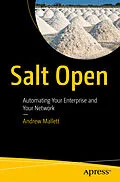There is a rapid growth of automation in server rooms and data centers. The days of having many administrators running around busily configuring and maintaining servers are gone and have been replaced with droves of Salt-Minions; agents beavering away on the target nodes ensuring the configuration is as specified. This book covers Salt Open (also known as SaltStack Open) from the ground up and shows you how to work with two Linux distributions.
You'll see how Salt Open is duplicated with ArubaOS and IOS networking devices, which can be configured without the underlying OS. As you step through the configuration options, you'll learn how to run remote execution modules from the CLI before looking at stateful configuration using SLS files. Moving on, you'll learn how to configure the systems where you also need to monitor your devices and that is when reactors and beacons come into play. Creating beacons to alert the server when thresholds are exceeded, you will be able to create reactors to mitigate the issues identified by the beacons.
By the end of this book, you will be able to deploy Salt to your servers and network infrastructure. You will be able to install the Salt-Master and Salt-Minion, executing commands from both the Master and the Minion. The networking devices you need to manage will be controlled through the Salt_Proxy Minions that you have configured. Finally, you will be able to load-balance connections to the master with Salt-Syndic.
You will:
- Install Salt Services on Ubuntu and CentOS based systems
- Work with remote execution modules
- Format YAML files correctly
- Provide defined configuration using state files
- Use Salt-Proxy to configure network devices
- Automate the configuration of Linux servers and networking devices
- Providing value for both the server and network automation team
Autorentext
Andrew is a well known Linux consultant and trainer, his YouTube Channel has over 65K subscribers and more than 1000 videos. Working mainly online now Andrew has authored courses on both Pluralsight and Udemy and regularly teaches classes online to a worldwide audience. Andrew is familiar with Linux and UNIX and has worked with them for over 20 years. Scripting and automation is one of his passions as he is inherently lazy and will always seek the most effective way of getting the job done. The Urban Penguin, his alter-ego, is a UK based company where his work is created from and currently employs 5 people.
Inhalt
Chapter 1: Understanding Salt and Configuration Automation
No of pages 8
Chapter Goal: In this chapter we will outline the labs systems used throughout the book and optional networking equipment before moving onto installing the Salt-Master Salt-Minions and providing basic tests
No of pages: 12
Sub - Topics
1. Identity Lab setup
2. Install latest version of Salt Master and Minions
3. Configuring Master and Minions4. Configuring Times Services
5. Signing Keys
6. Implementing basic tests
7. Implement firewalling on the Salt Master
Chapter 3: Installing Additional MinionsChapter Goal: We have just one server and a Minion on the same server. We will now expand this to include additional Linux distribution and learn more about Salt authentication
No of pages : 8
Sub - Topics:
1. Authenticating with Minion public keys and key management
2. Automating key signing
3. Locating the Salt Master
4. Automating the Minion IDChapter 4: Targeting Minions
Chapter Goal: Learn how we can target tasks to the required Minions in Salt Open
No of pages: 12
Sub - Topics:
1. Salt Targeting
2. Understanding grains and using them as targets
3. Targeting using regular expressions and IP notation
4. Creating Node groups and using them as targets
Chapter 5: Working with Remote Execution Modules in Salt Open
Chapter Goal: At the heart of Salt we have remote execution modules and we stale a look at the construction in Python and how we use them and find their documentation
No of pages: 15
Sub topics
1. Using Modules and Functions
2. Listing the salt module indices
3. Using salt and salt-call to execute modules4. Locate command line help
5. The big three: packages, services, and files
Chapter 6: Writing YAMLChapter Goal: Learn to write and understand YAML files. Configure your command line editor for YAML
No of pages: 8
Sub - Topics:
1. YAML Ain't Markup Language
2. Using Online Parser to process YAML
3. Configuring the nano editor
4. Configuring the vim editor for YAML and SLS files
Chapter 7: Writing Salt State Files
Chapter Goal: Create repeatable configurations using SLS files
No of pages: 15
Sub - Topics:
1. &n...